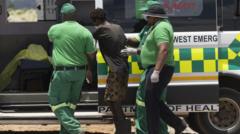Despite the successful rescue of over 200 survivors from the mine in Stilfontein, South Africa, volunteers report that there are no more illegal miners left underground. The situation escalated as a court ordered the government to assist in rescue efforts, which began amid a crackdown on illegal mining operations.
Since the operation commenced, authorities have unearthed 78 bodies, and medical checks for survivors are underway. Many of them had been trapped for months without food and water, leading to severe malnutrition. The struggle against illegal mining is compounded by a lack of economic opportunities, driving individuals to work in dangerous, gang-controlled environments.
As the rescue operations conclude, the government plans to charge the surviving miners with illegal mining and related offenses. This reflects the tensions between economic needs and strict enforcement policies amidst a high unemployment rate exceeding 30%. With a legacy of gang control in the mining sector, South Africa faces a pressing need to address the roots of illegal mining and its dangerous implications.
Since the operation commenced, authorities have unearthed 78 bodies, and medical checks for survivors are underway. Many of them had been trapped for months without food and water, leading to severe malnutrition. The struggle against illegal mining is compounded by a lack of economic opportunities, driving individuals to work in dangerous, gang-controlled environments.
As the rescue operations conclude, the government plans to charge the surviving miners with illegal mining and related offenses. This reflects the tensions between economic needs and strict enforcement policies amidst a high unemployment rate exceeding 30%. With a legacy of gang control in the mining sector, South Africa faces a pressing need to address the roots of illegal mining and its dangerous implications.




















